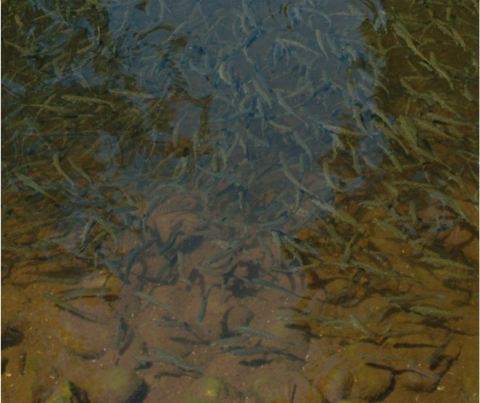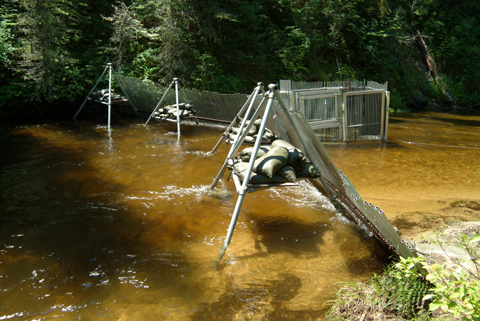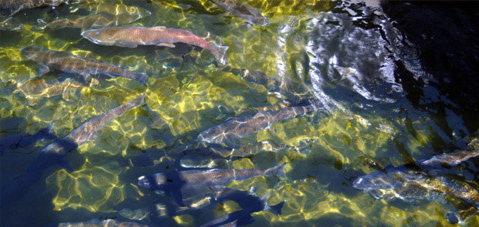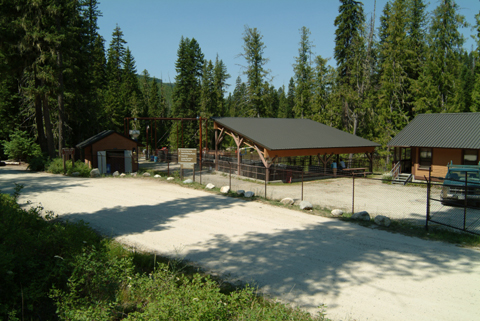Hidatsa Information
At Fort Mandan during the winter of 1804-1805, Lewis learned from the Hidatsa Indians about the Three Forks of the Missouri, and how following one of them would lead to “a chain of high mountains being the ridge that divides the waters of the Atlantic from those of the Pacific ocean.” Beyond the mountains there were no bison, but the natives “live principally on a large fish” taken from “a large river which washes [the mountains’] western base.” In the report he sent back to Thomas Jefferson via the barge (called the ‘boat’ or ‘barge’ but never the ‘keelboat’) in spring 1805, Lewis wrote:
This river we suppose to be the S. fork of the Columbia, and the fish the Salmon, with which we are informed the Columbia river abounds.—
Lewis was familiar with Atlantic salmon, and recognized the same creature when a Shoshone served him freshly roasted salmon on August 13, 1805, the day of their meeting: “this was the first salmon I had seen and perfectly convinced me that we were on the waters of the Pacific ocean.” The main biological difference between Pacific and Atlantic salmon is that the former spawn only once and then die; the latter can spawn as many as four times. Both are anadromous (ann-ADD-roe-muss) fish, meaning they are born in fresh water but spend most of their adult lives in salt water. (The opposite of anadromous fish are “resident” species like trout and sturgeon, which never leave fresh water.) Pacific salmon and other fish were the staff of life for all the native peoples that the expedition met on the west side of the Rocky Mountains in 1805-1806. Fish were also, of necessity, the basis of the Corps’ menus during their nearly 10 months west of the Rockies, although their hunters harvested as many elk and deer as possible, to satisfy their continuing hunger for red meat.
“Salmon and His People”
As the salmon’s flesh was a mainstay of native life along the Columbia and its tributaries, so Salmon as spirit was and is a mainstay of native religion in that part of the continent.
Accounting for dinosaur bones and isolated boulders found in their land, Nez Perce creation stories describe the time when the Creator told the original “large animals” that a new creature, the human being, was now coming to live among them. Human beings would be naked and life for them would be difficult, so the animals had to offer ways in which they would help human beings. The animals could also choose how they would live and what they would look like from then on. Large animals who arrived late at the big meeting the Creator immediately turned to stone, and their bodies can still be seen as boulders along the Clearwater River.
When Salmon’s and Steelhead’s turn came, they said to the Creator, as recounted today by Allen Pinkham,
“We can help the human beings with our flesh.” Salmon said, “When we come up the river we will die, so the human beings will have to catch us before that happens. I’ll come up only on certain times of the year and that’s when they’ll have to catch me.” Then Steelhead said, “I want to come in the wintertime, but I’ll give them something special. That will be the glue from my skin. This glue can be used to make bows and spears. I’ll be in the water all winter long.[1]Dan Landeen and Allen Pinkham. Salmon and His People: Fish & Fishing in Nez Perce Culture (Lewiston, ID: Confluence Press, 1999). The title of this book, copyrighted by the Nez Perce Tribe, says … Continue reading
The Creator accepted Salmon and Steelhead, among other Columbia River fish, to survive and help the human beings.
Salmon Cycle
Leroy Seth, another Nez Perce, explains that, still today,
The salmon are one of our best teachers. We learn from them that we have to do certain things by the seasons. We watch the salmon as smolts[2]Smolts are young adult salmon leaving their freshwater “nursery” and moving out to the ocean for their adult life. going to the ocean and observe them returning home. We see the many obstacles that they have to overcome. We see them fulfill the circle of life, just as we must do.[3]Salmon and His People, p. 3.
The Nez Perce new year began in April, when the first roots were ready for harvest along the river bottoms, and thanks were given for the renewal of the annual food cycle. (Many other Native American give thanks when harvesting begins, rather than—like Europeans—waiting for the end and seeing how big the take was. Gratitude is given that there will be food, rather than for how much.)
In June, the people moved to higher elevations to harvest berries and different roots, and to hunt deer and elk. Soon they harvested eels, a favorite fish, and “blue back salmon,” or the steelhead trout (a relative of salmon), in the upper rivers. Chinook salmon, the favored salmon species, followed in July and August. When snow arrived in the mountains, the people returned to their river-bottom longhouses with fish, roots, and berries they had dried throughout the warm months. Salmon provided four-fifths of the protein in their diet.
The Nez Perce still celebrate the salmon’s return with a First Salmon Ceremony, in which the food is prepared in the traditional way by selected people who know the right songs. Salmon, meat, and berries are on the menu, and all the people eat together, beginning by formally tasting each food separately.[4]Explained by Carla HighEagle, ibid., p 57. native nations throughout the Columbia River Basin had First Salmon Ceremonies. Some tribes release the first salmon back into the river, some feed it only (or first) to the children, others dance or sing or drum—but all the ceremonies begin with thanks to Salmon.
First Salmon Ceremony
The Corps of Discovery was among the Teninos and Watlalas below The Dalles of the Columbia on 18 April 1806, when the first salmon of the spring run arrived. The captains recorded the First Salmon Ceremony, but they missed its religious significance. They applied their non-judgmental term for “unscientific” to the rite, calling it “superstitious.” The next day, Lewis wrote:
there was great joy with the natives last night in consequence of the arrival of the salmon; one of those fish was caught; this was the harbinger of good news to them. they informed us that these fish would arrive in great quantities in the course of about 5 days. this fish was dressed and being divided into small pieces was given to each child in the village. this custom is founded in a supersticious opinion that it will hasten the arrival of the salmon.
River or Reservoir?
When Americans moved into the Columbia basin in the 1840s, ’50s, and ’60s, they joined the natives in fishing for salmon. The first commercial salmon processing plant—its product salted and shipped in barrels—opened on the lower Columbia in 1866;[5]Artificial Production Review: Report and Recommendations of the Northwest Power Planning Council. Council Document 99-15, 13 October 1999, p. 64. canning would replace salting in the 1880s.
Overfishing the spring chinook run was soon a problem, and a consortium of processors created the first salmon hatchery in 1877. (They also began fishing the fall chinook run.) Drawing on the expertise of the U.S. Bureau of Fisheries, headed by zoologist Spencer Fullerton Baird,[6]Baird (1823-1887), was appointed Assistant Secretary of the Smithsonian Institution at the youthful age of twenty-seven and became its Secretary (director) in 1878. He was named the first … Continue reading they financed the facility and ran it for five years.[7]Artificial Production Review, p. 65. State- and federally-owned hatcheries in the Columbia River Basin began to follow in 1888, when the State of Oregon leased and reopened the consortium’s hatchery. (Washington first state-owned hatchery opened on the Kalama River in 1895, and Idaho’s in 1934 on the upper Snake River.) Never since 1877 have the salmon in the Columbia been entirely wild-born.
The early hatcheries’ purpose was simply to increase the harvest for commercial fishery which, according to Thomas C. Dewberry, “peaked in 1895 when 13,800 metric tons of salmon (4—6 million fish) were caught and canned.”[8]Thomas C. Dewberry is a restoration ecologist and the author of Restoring the River: A Plan for the Chinook Watershed (Portland, OR: Sea Resources and Ecotrust, 1997. See … Continue reading Their model was agricultural, with Baird famously claiming that “one acre of water was worth seven acres of land if properly cultivated.”[9]Artificial Production Review, p. 76. and other scientists of the day disagreeing only to increase the ratio in favor of hatcheries.
Some salmon still escaped the commercial nets to reach their upper Columbia, Snake, and Clearwater spawning grounds, but their numbers and their individual sizes decreased as commercial fishermen picked off the largest fish and hatcheries bred from smaller specimens.
Hatcheries and Migration
Some of the salmon swimming up Lolo Creek to spawn are captured by this trap for transport to and breeding in Nez Perce Tribal Hatchery Program facilities.
The statistics of salmon survival are instructive: Imagine 3,000 salmon eggs, a female’s normal output. From them, 500 fry will hatch, but only 45 fry will grow to smolt stage and reach the sea. Ocean fishing, natural predation, and the rigors of returning upstream will kill off all but 2 to 5 adults who succeed in returning to their spawning ground. If 5 return, they’ve beat odds of 600 to 1 against them.[10]NOAA’s National Marine Fisheries Service, Northeast Fisheries Science Center website, http://www.nefsc.noaa.gov/faq/fishfaq2d.html on 3/31/05
Between 1932 and 1973, the Columbia River was totally reshaped with the construction of dams for hydropower, flood control, recreation, and (theoretically) conservation. Today, more than 400 dams exist in the Columbia River Basin from British Columbia to the mainstem, which itself holds 11 major dams.[11]William Lang, Professor of History at Portland State University and former Director of the Center for Columbia River History. Posted at http://www.ccrh.org/river/history.htm and accessed 03/29/05. They are managed by federal agencies including U.S. Army Corps of Engineers and Bureau of Land Management, and by state agencies and tribal entities including the Yakamas and Nez Perces.
From a river flowing freely for about 1,200 miles from Columbia Lake in British Columbia to the Pacific Ocean, the Columbia was converted into a series of lakes stretching between dams that constantly control water flow from one lake to the next. The same happened on tributaries including the Clearwater River in Idaho and Washington and the Snake River in Idaho.
Some dams have fish ladders that allow spawning fish to swim up and through, but on others only the smolts heading downstream to the ocean can pass through the dams. Hatcheries were created above blocking dams to replace local populations—salmon and steelhead—that never could return to spawn naturally in their native waters. Thus some hatcheries were assigned to replace fish rather than increase the harvest.
Wild vs. Hatchery
The White Sands Creek satellite facility, managed by Idaho Department of Fish and Game. Here, in the high tributaries of the Lochsa River, some adult salmon that have successfully returned to their home water to spawn are captured, processed, and then taken to the Clearwater Hatchery near Orofino for spawning. They are later released back into White Sands Creek.
In the wild, female salmon lay their eggs and males fertilize them in sand or gravel beds under unimpeded, flowing freshwater. Pacific salmon adults then soon die. From the eggs come “alevin” (uh-LEV-un), immature fish with egg sacs attached to their bellies until the enclosed nutriment is consumed. Now looking like fish, the surviving “fry” hide from predators by taking on camouflage markings that match their surroundings; they hide under surface detritus, and feed below surface. They grow to “parrs” or “fingerlings” (so named because of their pinkish bar-shaped markings).
After maturing further, to the “smolt”—young adult—stage, salmon and steelhead are ready to leave freshwater. They begin the long and dangerous downstream journey toward the ocean. The smolts’ age varies by species, being as low as one week in chum and pink salmon, to as great as 36 months in sockeye (“red salmon”). Pausing in the Columbia estuary where fresh- and saltwater mix, the creatures acclimate until moving out into the Pacific Ocean for their adult lives. They travel hundreds of miles from the mouth of the Columbia, so that maybe even some “wild salmon” netted at sea began life in a hatchery. In the late 1990s, Columbia River Basin hatchery fish accounted for about 50% of fall chinook, 70% to 80% of spring/summer chinook, 70% of steelhead, and 95% of coho.[12]Statistics from National Marine Fisheries Service, quoted in Artificial Production Review, p. 1.
In traditional hatcheries, salmon and steelhead on their spawning run are captured and monitored. When the females are ready to lay their eggs, people harvest eggs and sperm and artificially inseminate the eggs. Fertilized eggs are counted and placed in trays in carefully monitored indoors facilities. The hatched alevins are moved outdoors into concrete rectangles open to the sky, with no camouflage pattern or sheltering detritus. Nutritionally balanced feed is thrown onto the water. With open space instead of riverine trees species surrounding the ponds, fewer predators can threaten—or educate—salmon and steelhead about natural dangers. Humans again handle the fish at smolt stage, planting them in designated streams for harvest, sportfishing, and/or species survival.
Fish bred in traditional hatcheries, according to Silas Wittman, a former Nez Perce Fisheries manager, look
like shiny nickels when they’re released into the river. They’ve never seen a predator in their life, they have no camouflage, and they’ve been trained to only eat from the water’s surface.[13]Quoted in Jeremy FiveCrows, “The Nez Perce Tribe Has Combined Traditional Knowledge with State-of-the-Art Science To Create an Innovative Hatchery in the Heart of Their Reservation,” Wana … Continue reading
Mitigation
Fish hatcheries were intended to “mitigate,” or make less severe, human changes that altered fish life cycles—changes from dams, riverside development including roading, and environmental changes caused by human activities from manufacturing to waterskiing. Goals of an individual hatchery could include any combination of: preserving the species, augmenting the harvest, maintaining a species in a location where an altered environment no longer supported it, increase the population where it has decline, restoring a salmon population to an area where it had died out, and researching for future hatchery and river improvements.
By the 1990s, scientists had begun to divide into those who believed that hatcheries succeeded and those who saw them as failures. Arguments against hatcheries include that they:
- lessen genetic diversity within a population through inbreeding;
- lessen genetic diversity among different populations by mingling them in hatcheries and when planting them;
- semi-domesticate the fish;
- easily spread diseases among fish populations;
- become self-perpetuating rather than achieving the goal for a certain fish population and then closing down.[14]Artificial Production Review, pp. 108-121.
But some authorities argue that so many other changes have been made to the environment that hatcheries are now the only way to keep anadromous fish species alive in the Columbia River and its tributaries. While scientists continue to wage this debate, little of it has leaked to the popular press.
New Methods
In recent years, new-style hatcheries have begun to appear in the Northwest. One in the Columbia River Basin is sponsored by the Yakama Nation (at Cle Elum, Washington, dedicated 1997) under the Northwest Power and Conservation Council.[15]Northwest Power and Conservation Council at http://www.nwcouncil.org/library/2003/2003-14/cleelum.htm/ The Cle Elum Supplementation and Research Facility uses “semi-natural treatment” methods, beginning by randomly catching spawning salmon from the Yakima River. A control group is raised in a traditional hatchery, with a second group given ponds with underwater camouflage paint, underwater feeders, and natural surface and streamside cover. The hatchery’s first adult salmon returned in 2001, and studying them continues.
In 2005, the Nez Perce Tribe opened a salmon hatchery at Cherrylane, Idaho, one that even more closely mimics the natural setting. Fish swim in S-shaped concrete ponds painted underwater with camouflage, through which flows diverted creek water over rocks, sunken logs, and a natural insect population. “Streamside” riverine trees and shrubs are planned. Water-flow speed, volume, and temperature are altered to imitate seasonal changes of wild streams.
At the Nez Perce hatchery, the young salmon are not protected from predators like kingfishers and mergansers. Satellite facilities allow the smolts to acclimate to the specific streams they are meant for, before being released. The goal—not measurable until 2010 and after—is that the mature salmon will return to their release locations to spawn, becoming a naturally sustaining population.
While scientists continue to argue over the value of hatcheries in general, Nez Perce Tribe Fisheries Department manager Dave Johnson places the Cherrylane hatchery in his people’s cultural context:
We will treat these fish with the respect they deserve. They are not ours to do with what we will. Rather, they are a part of us; they share our world.[16]Ibid.
With thanks to Don Skaar, Pollution Control Biologist, Montana Department of Fish, Wildlife and Parks; and Mike Demick, Regional Conservation Educator, Idaho Department of Fish and Game.
Notes
| ↑1 | Dan Landeen and Allen Pinkham. Salmon and His People: Fish & Fishing in Nez Perce Culture (Lewiston, ID: Confluence Press, 1999). The title of this book, copyrighted by the Nez Perce Tribe, says it all about Salmon’s importance. |
|---|---|
| ↑2 | Smolts are young adult salmon leaving their freshwater “nursery” and moving out to the ocean for their adult life. |
| ↑3 | Salmon and His People, p. 3. |
| ↑4 | Explained by Carla HighEagle, ibid., p 57. |
| ↑5 | Artificial Production Review: Report and Recommendations of the Northwest Power Planning Council. Council Document 99-15, 13 October 1999, p. 64. |
| ↑6 | Baird (1823-1887), was appointed Assistant Secretary of the Smithsonian Institution at the youthful age of twenty-seven and became its Secretary (director) in 1878. He was named the first commissioner of the U.S. Bureau of Fisheries—forerunner of today’s National Marine Fisheries Service—in 1871, and established the Woods Hole Marine Biological Laboratory on Cape Cod in 1888. Modern scientists express surprise at his accepting the agricultural model for hatcheries. |
| ↑7 | Artificial Production Review, p. 65. |
| ↑8 | Thomas C. Dewberry is a restoration ecologist and the author of Restoring the River: A Plan for the Chinook Watershed (Portland, OR: Sea Resources and Ecotrust, 1997. See http://www.ecotrust.org/publications/chinook_historical_look.html Dewberry also notes that the population of Astoria, Oregon, near Fort Clatsop increased tenfold from 200 to 2,000 in 1874-1876, as fishermen and processors moved there. |
| ↑9 | Artificial Production Review, p. 76. |
| ↑10 | NOAA’s National Marine Fisheries Service, Northeast Fisheries Science Center website, http://www.nefsc.noaa.gov/faq/fishfaq2d.html on 3/31/05 |
| ↑11 | William Lang, Professor of History at Portland State University and former Director of the Center for Columbia River History. Posted at http://www.ccrh.org/river/history.htm and accessed 03/29/05. |
| ↑12 | Statistics from National Marine Fisheries Service, quoted in Artificial Production Review, p. 1. |
| ↑13 | Quoted in Jeremy FiveCrows, “The Nez Perce Tribe Has Combined Traditional Knowledge with State-of-the-Art Science To Create an Innovative Hatchery in the Heart of Their Reservation,” Wana Chinook Tymoo: The Magazine of the Columbia River Inter Tribal Fish Commission, posted on http://www.critfc.org/wana/hatchery.html/ and accessed 04/01/05. |
| ↑14 | Artificial Production Review, pp. 108-121. |
| ↑15 | Northwest Power and Conservation Council at http://www.nwcouncil.org/library/2003/2003-14/cleelum.htm/ |
| ↑16 | Ibid. |
Experience the Lewis and Clark Trail
The Lewis and Clark Trail Experience—our sister site at lewisandclark.travel—connects the world to people and places on the Lewis and Clark Trail.
Discover More
- The Lewis and Clark Expedition: Day by Day by Gary E. Moulton (University of Nebraska Press, 2018). The story in prose, 14 May 1804–23 September 1806.
- The Lewis and Clark Journals: An American Epic of Discovery (abridged) by Gary E. Moulton (University of Nebraska Press, 2003). Selected journal excerpts, 14 May 1804–23 September 1806.
- The Lewis and Clark Journals. by Gary E. Moulton (University of Nebraska Press, 1983–2001). The complete story in 13 volumes.





